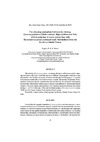Please use this identifier to cite or link to this item:
https://accedacris.ulpgc.es/jspui/handle/10553/56319
| DC Field | Value | Language |
|---|---|---|
| dc.contributor.author | Espino, F. | en_US |
| dc.contributor.author | Riera, R. | en_US |
| dc.date.accessioned | 2019-08-07T14:48:52Z | - |
| dc.date.available | 2019-08-07T14:48:52Z | - |
| dc.date.issued | 2017 | en_US |
| dc.identifier.issn | 1130-4723 | en_US |
| dc.identifier.other | Dialnet | - |
| dc.identifier.uri | https://accedacris.ulpgc.es/handle/10553/56319 | - |
| dc.description.abstract | The activity of Lysmata grabhami as cleaner shrimp is well known, and its cleaning mutalism with many client fish species in different biogeographic areas have been documented. The literature reviewed resulted in 49 fish species belonging to 15 families to be cleaned at both sides of the Atlantic Ocean. Overall, Muraenidae, Serranidae, Pomacentridae, Holocentridae and Acanthuridae were the families that accounted more species of client fish; both families and the pool of species were different at Western and Eastern Atlantic. This work reports and describes a new cleaning interaction between the cleaner shrimp, L. grabhami (Gordon, 1935), and the island grouper, Mycteroperca fusca (Lowe, 1838) from the Canary Islands, North-eastern Atlantic Ocean. | en_US |
| dc.language | eng | en_US |
| dc.relation.ispartof | Revista de la Academia Canaria de Ciencias | en_US |
| dc.source | Revista de la Academia Canaria de Ciencias [ISSN 1130-4723], v. 29 (1), p. 49-60 | en_US |
| dc.subject | 2510 Oceanografía | en_US |
| dc.subject.other | Cleaner shrimp | en_US |
| dc.subject.other | Island grouper | en_US |
| dc.subject.other | Symbiosis | en_US |
| dc.subject.other | Atlantic Ocean | en_US |
| dc.subject.other | Canary Islands | en_US |
| dc.subject.other | Gamba limpiadora | en_US |
| dc.subject.other | Abade (Peces) | en_US |
| dc.title | The cleaning mutualism between the shrimp, Lysmata grabhami (Malacostraca: Hippolytidae) and fish, with description of a new interaction with Mycteroperca fusca (Actinopterygii: Serranidae) from the Eastern Atlantic Ocean | en_US |
| dc.type | info:eu-repo/semantics/article | en_US |
| dc.type | Article | en_US |
| dc.identifier.url | http://dialnet.unirioja.es/servlet/articulo?codigo=6464130 | - |
| dc.description.lastpage | 60 | en_US |
| dc.identifier.issue | 1 | - |
| dc.description.firstpage | 49 | en_US |
| dc.relation.volume | 29 | en_US |
| dc.investigacion | Ciencias | en_US |
| dc.type2 | Artículo | en_US |
| dc.description.notas | Ejemplar dedicado a: Biología | en_US |
| dc.contributor.authordialnetid | 2332186 | - |
| dc.contributor.authordialnetid | No ID | - |
| dc.identifier.dialnet | 6464130ARTREV | - |
| dc.description.numberofpages | 12 | en_US |
| dc.utils.revision | Sí | en_US |
| dc.identifier.ulpgc | Sí | en_US |
| dc.contributor.buulpgc | BU-BAS | en_US |
| item.fulltext | Con texto completo | - |
| item.grantfulltext | open | - |
| crisitem.author.dept | GIR ECOAQUA: Biodiversidad y Conservación | - |
| crisitem.author.dept | IU de Investigación en Acuicultura Sostenible y Ecosistemas Marinos (IU-Ecoaqua) | - |
| crisitem.author.dept | GIR ECOAQUA: Biodiversidad y Conservación | - |
| crisitem.author.dept | IU de Investigación en Acuicultura Sostenible y Ecosistemas Marinos (IU-Ecoaqua) | - |
| crisitem.author.dept | Departamento de Biología | - |
| crisitem.author.orcid | 0000-0003-1264-1625 | - |
| crisitem.author.parentorg | IU de Investigación en Acuicultura Sostenible y Ecosistemas Marinos (IU-Ecoaqua) | - |
| crisitem.author.parentorg | IU de Investigación en Acuicultura Sostenible y Ecosistemas Marinos (IU-Ecoaqua) | - |
| crisitem.author.fullName | Espino Rodríguez, Fernando | - |
| crisitem.author.fullName | Riera Elena, Rodrigo | - |
| Appears in Collections: | Artículos | |
Page view(s)
362
checked on Jan 15, 2026
Download(s)
218
checked on Jan 15, 2026
Google ScholarTM
Check
Share
Export metadata
Items in accedaCRIS are protected by copyright, with all rights reserved, unless otherwise indicated.
